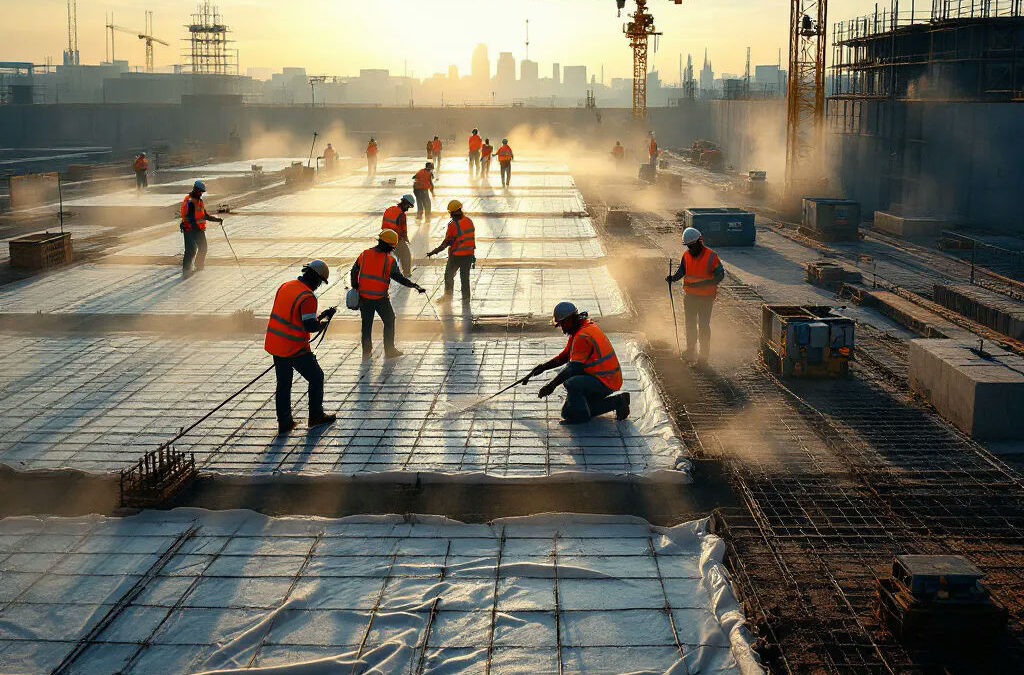I. Introduction
Curing is a critical component in the success of concrete projects, particularly in commercial applications where quality and durability are paramount. The role of curing is often underestimated, yet it significantly impacts the overall integrity of the concrete. This article aims to provide a comprehensive understanding of curing times and techniques that should be considered when working with commercial concrete.
II. What is Concrete Curing?
Concrete curing refers to the process of maintaining adequate moisture, temperature, and time to allow the concrete to achieve its desired strength and durability. This process is primarily driven by hydration, a chemical reaction between water and cement that forms a hard structure over time. Proper curing enhances the strength, durability, and longevity of concrete, making it crucial for achieving optimal performance in commercial installations. For a complete overview of how curing fits into the larger project timeline, visit our
project process guide.
III. Factors Influencing Curing Time
A. Type of Concrete Mix
Different types of concrete mixes present varying curing requirements. Standard concrete typically requires longer curing times compared to high-strength concrete, which can set more quickly due to additional additives. Rapid-setting concrete, designed for quick applications, has the shortest curing window, necessitating careful monitoring to ensure it reaches its optimal strength before exposure to loads. Learn more about choosing the right mix in
this article.
B. Environmental Conditions
Environmental factors play a significant role in curing times. High temperatures can accelerate drying, necessitating more frequent watering, while lower temperatures may slow the curing process, extending the required time. Wind and humidity levels also greatly influence moisture retention; high winds can hasten evaporation, while high humidity may aid in maintaining moisture levels.
C. Thickness of the Concrete Pour
The thickness of the concrete pour is another critical factor affecting curing time. Thicker pours require longer curing times for the inner core to hydrate fully, and ensuring that moisture is retained throughout the mass can be challenging. Adequate measures must be taken to ensure that thicker pours receive proper attention during the curing phase.
D. Time of Year and Weather Considerations
Seasonal changes and unexpected weather patterns can disrupt the curing process. For example, pouring concrete in the colder months may necessitate special precautions to prevent freezing, while extreme heat can lead to rapid evaporation. Understanding weather patterns and planning accordingly is essential for successful curing.
IV. Standard Curing Times
A. General Guidelines for Curing Times
General guidelines suggest that standard concrete should be cured for a minimum of 7 days, while high-strength variants may require as little as 3 days. However, more complex projects might necessitate longer durations depending on specific conditions and desired outcomes. Adhering to these guidelines is essential for achieving concrete that can withstand the test of time.
B. Different Curing Times for Varying Types of Concrete
Curing durations can differ significantly based on the type of concrete. For instance, while standard concrete benefits from seven days of curing, rapid-setting concrete may only need a few hours. Understanding these variations is vital for construction managers and project planners to ensure that each mix is treated appropriately. For insights into construction best practices, read
Top 7 Mistakes to Avoid.
C. Importance of Following Recommended Times
Following the recommended curing times is crucial to developing the strength and durability expected in commercial projects. Neglecting this aspect can lead to long-term issues such as cracking, spalling, and reduced load-bearing capacity, which can result in costly repairs and project delays. Awareness of and adherence to curing protocols can ultimately safeguard the investment made in concrete infrastructure.
V. Methods of Curing Concrete
A. Moist Curing
Moist curing is one of the most effective methods for maintaining hydration in newly placed concrete. Techniques include covering the surface with wet burlap or frequent spraying with water to ensure the concrete remains damp. While highly beneficial, these methods can require significant labor and monitoring to maintain the appropriate moisture levels.
B. Cover Curing
Using curing blankets is another popular method, particularly in cooler climates. These blankets help retain heat and moisture, ensuring a controlled curing environment. This method can be advantageous when quick insulation of newly poured concrete is needed, allowing for continued work in adverse weather conditions.
C. Chemical Curing Agents
Chemical curing compounds serve as a practical alternative to traditional curing methods. These compounds work by forming a film on the surface that reduces moisture loss while allowing for proper hardening. The application of these agents requires careful attention to detail to ensure even distribution and effectiveness.
VI. Best Practices for Curing in Commercial Concrete Projects
A. Planning for Curing in Project Schedules
Incorporating curing times into project schedules is a vital best practice. Planning ahead can prevent delays and ensure that all team members understand the importance of curing in the overall timeline. Scheduling regular check-ins can also help ensure concrete remains adequately cured throughout the process. For advice on successful planning and budgeting, see
this contractor’s guide.
B. Monitoring Environmental Conditions
Continuous monitoring of environmental conditions is essential during the curing phase. Utilizing tools such as moisture meters and weather tracking systems can provide insights into potential issues, allowing for real-time adjustments to curing practices. Being proactive can greatly enhance the quality of the final product.
C. Quality Control Measures During the Curing Process
Implementing quality control measures during curing helps ensure the desired outcomes are met. Regular inspections can catch any potential problems early, enabling corrective actions before it’s too late. This focus on quality can add value to any commercial project. Visit
Key Safety Measures to improve reliability during concrete work.
D. Documentation and Reporting
Thorough documentation of the curing process is essential for accountability and future reference. Keeping records of environmental conditions, curing methods employed, and any alterations made allows for better oversight. This practice can also facilitate troubleshooting and improvements in future projects.
VII. Common Curing Challenges
A. Weather-Related Issues
Weather-related challenges, such as unexpected rain or temperature fluctuations, can severely impact the curing process. In these instances, it is crucial to have contingency plans in place to adjust curing methods or cover concrete for protection. Quickly adapting to these challenges is key to maintaining curing integrity.
B. Scheduling Conflicts
Scheduling conflicts can arise when multiple trades are involved in a project, potentially compromising curing times. Clear communication and coordination among different teams can mitigate these conflicts, ensuring that proper curing practices remain a priority as the project progresses.
C. Site Access and Logistics
Access to the site can also pose challenges, especially in larger projects where remote locations may hinder the delivery of necessary curing supplies. Effective logistical planning can help ensure that all materials and personnel are in place when needed, facilitating a smoother curing process.
D. Solutions and Mitigation Strategies
Implementing strategies to overcome common curing challenges, such as using mobile curing units or increasing the use of automation technology, can lead to more efficient processes. By anticipating potential hurdles and planning accordingly, teams can greatly enhance the curing outcomes. Learn more about commercial vs. residential challenges


